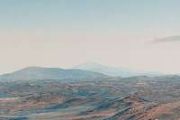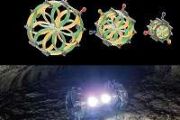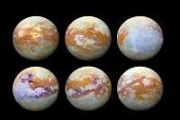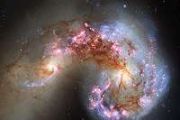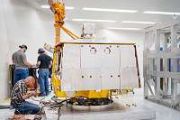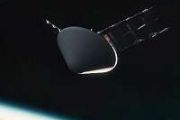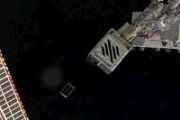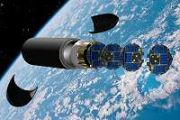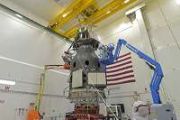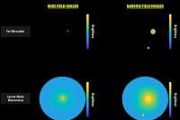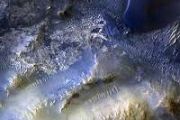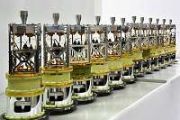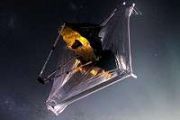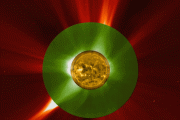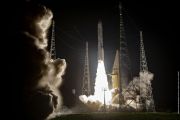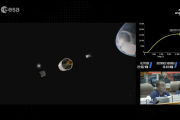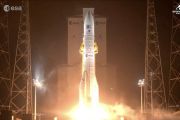
Copernical Team
The pierogi challenge
 Image:
The pierogi challenge
Image:
The pierogi challenge Jumping workouts could help astronauts on the moon and Mars
 Jumping workouts could help astronauts prevent the type of cartilage damage they are likely to endure during lengthy missions to Mars and the Moon, a new Johns Hopkins University study suggests.
The research adds to ongoing efforts by space agencies to protect astronauts against deconditioning/getting out of shape due to low gravity, a crucial aspect of their ability to perform spacewalks,
Jumping workouts could help astronauts prevent the type of cartilage damage they are likely to endure during lengthy missions to Mars and the Moon, a new Johns Hopkins University study suggests.
The research adds to ongoing efforts by space agencies to protect astronauts against deconditioning/getting out of shape due to low gravity, a crucial aspect of their ability to perform spacewalks, Chinese space firm showcases mobile-to-satellite communication tech
 Chinese space technology company GalaxySpace has successfully demonstrated mobile-to-satellite communication technology utilizing China's first low-Earth orbit broadband communication test constellation. The demonstration took place during a commercial space conference in Beijing on Wednesday.
At precisely 10:28 am, a satellite from the constellation passed over the conference venue, locat
Chinese space technology company GalaxySpace has successfully demonstrated mobile-to-satellite communication technology utilizing China's first low-Earth orbit broadband communication test constellation. The demonstration took place during a commercial space conference in Beijing on Wednesday.
At precisely 10:28 am, a satellite from the constellation passed over the conference venue, locat New research explores CubeSat swarms for spacecraft servicing and repair
 As space agencies and private companies design satellites and telescopes with repairability in mind, the need for efficient servicing trajectories becomes crucial. Researchers from the Department of Aerospace Engineering at The Grainger College of Engineering, University of Illinois Urbana-Champaign, have developed a new method enabling multiple CubeSats to coordinate in servicing and assembling
As space agencies and private companies design satellites and telescopes with repairability in mind, the need for efficient servicing trajectories becomes crucial. Researchers from the Department of Aerospace Engineering at The Grainger College of Engineering, University of Illinois Urbana-Champaign, have developed a new method enabling multiple CubeSats to coordinate in servicing and assembling K2 Space secures $110M Series B funding and achieves first in-space demonstration
 K2 Space has announced the successful completion of a $110 million Series B funding round aimed at scaling up production of its advanced, high-power satellite platform. The investment, co-led by Lightspeed Venture Partners and Altimeter Capital, also included participation from existing stakeholders such as Alpine Space Ventures and First Round Capital. This achievement coincides with the compan
K2 Space has announced the successful completion of a $110 million Series B funding round aimed at scaling up production of its advanced, high-power satellite platform. The investment, co-led by Lightspeed Venture Partners and Altimeter Capital, also included participation from existing stakeholders such as Alpine Space Ventures and First Round Capital. This achievement coincides with the compan Redwire Secures ESA Contract to Develop Next Dark Matter Mission Concept
 Redwire Corporation (NYSE: RDW), a leading provider of space infrastructure solutions, has been awarded a study contract by the European Space Agency (ESA) to develop an initial spacecraft design for a new astrophysics mission. This mission aims to capture images of faint galaxies in the nearby universe, shedding light on the elusive nature of dark matter.
Redwire's Belgian subsidiary, Red
Redwire Corporation (NYSE: RDW), a leading provider of space infrastructure solutions, has been awarded a study contract by the European Space Agency (ESA) to develop an initial spacecraft design for a new astrophysics mission. This mission aims to capture images of faint galaxies in the nearby universe, shedding light on the elusive nature of dark matter.
Redwire's Belgian subsidiary, Red NASA Successfully Joins Sunshade to Roman Observatory's 'Exoskeleton'
 NASA's Nancy Grace Roman Space Telescope team has successfully integrated the mission's deployable aperture cover - a visor-like sunshade that will help prevent unwanted light from entering the telescope - to the outer barrel assembly, another structure designed to shield the telescope from stray light in addition to keeping it at a stable temperature.
"It's been incredible to see these ma
NASA's Nancy Grace Roman Space Telescope team has successfully integrated the mission's deployable aperture cover - a visor-like sunshade that will help prevent unwanted light from entering the telescope - to the outer barrel assembly, another structure designed to shield the telescope from stray light in addition to keeping it at a stable temperature.
"It's been incredible to see these ma NASA's SPHEREx Telescope to Explore Cosmic Reservoirs of Life's Building Blocks
 Water is essential for all known forms of life on Earth, leading scientists searching for extraterrestrial life to adopt the principle of "follow the water." NASA's upcoming SPHEREx (Spectro-Photometer for the History of the Universe, Epoch of Reionization, and Ices Explorer) mission, set for launch no earlier than Thursday, Feb. 27, will aid in this pursuit.
Launching aboard a SpaceX Falc
Water is essential for all known forms of life on Earth, leading scientists searching for extraterrestrial life to adopt the principle of "follow the water." NASA's upcoming SPHEREx (Spectro-Photometer for the History of the Universe, Epoch of Reionization, and Ices Explorer) mission, set for launch no earlier than Thursday, Feb. 27, will aid in this pursuit.
Launching aboard a SpaceX Falc NASA's Webb Uncovers Ancient Features of Trans-Neptunian Objects
 Trans-Neptunian objects (TNOs) are a diverse group of icy bodies orbiting beyond Neptune, ranging in size from dwarf planets such as Pluto and Eris, with diameters of approximately 1,500 miles, to much smaller objects like Arrokoth, spanning just tens of miles. First theorized by Kenneth Edgeworth and Gerard Kuiper in the 1950s, these celestial objects reside in what is now known as the Kuiper B
Trans-Neptunian objects (TNOs) are a diverse group of icy bodies orbiting beyond Neptune, ranging in size from dwarf planets such as Pluto and Eris, with diameters of approximately 1,500 miles, to much smaller objects like Arrokoth, spanning just tens of miles. First theorized by Kenneth Edgeworth and Gerard Kuiper in the 1950s, these celestial objects reside in what is now known as the Kuiper B How NASA's Lunar Trailblazer Will Chart a Unique Path to the Moon
 NASA's Lunar Trailblazer has arrived in Florida for final preparations ahead of its upcoming launch later this month. The small satellite, built by Lockheed Martin Space in Littleton, Colorado, has been integrated with a SpaceX Falcon 9 rocket. It will fly as part of Intuitive Machines' IM-2 mission under NASA's Commercial Lunar Payload Services (CLPS) initiative, with liftoff planned no earlier
NASA's Lunar Trailblazer has arrived in Florida for final preparations ahead of its upcoming launch later this month. The small satellite, built by Lockheed Martin Space in Littleton, Colorado, has been integrated with a SpaceX Falcon 9 rocket. It will fly as part of Intuitive Machines' IM-2 mission under NASA's Commercial Lunar Payload Services (CLPS) initiative, with liftoff planned no earlier 
